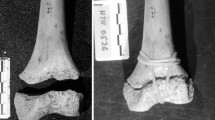Abstract
On radiographs flattening of the femoral head is evaluated by the Epiphyseal Index (EI). Using the ability of MRI to show articular cartilage and the physis clearly, we wish to propose the use of an Epiphyseal Index for MRI (EIM) and demonstrate the value in LCPD. Fifteen patients were examined using 1.5T MR scanner and T1-weighted coronal images were obtained. EIM was calculated as a ratio of height and width of cartilaginous contour surrounding epiphysis, and was compared between normal and the three radiographic stages. EIM of normal hips were ranged from 0.39 to 0.60 and had a tendency to decrease with increasing age. All cases of Stage 1 (avascular necrosis) were within the normal range (n=4, mean=0.51, SD=0.045). EIM of Stage 2 (fragmentation,n=15, mean=0.31, SD=0.055) were smaller than that of Stage 1. Stag 2 and 3 (residual,n=12, mean=0.31, SD=0.077) could not be distinguished by EIM. EIM was useful to show the flattening of epiphysis with growth and very important for differenciation between Stage 1 and 2 LCPD.
Similar content being viewed by others
References
Scoles PV, Yoon YS, Makley JT (1984) Nuclear magnetic resonance imaging in Legg-Calve-Perthes disease. J Bone Joint Surg [Am] 66:1357
Toby EB, Koman LA, Bechtold RE (1985) Magnetic resonance imaging of pediatric hip disease. J Pediatr Orthop 5:665
Ranner G, Ebner F, Fotter R (1989) Magnetic resonane imaging in children with acute hip pain. Pediatr Radiol 20:67
Brook E (1936) Osteochondritis deforman Coxae Juvenilis or Perthes' disease: The results of treatment by tractionin recumbency. Br J Surg 24:166
Heyman CH, Herndon CH (1950) Legg-Perthes Disease: A method for the measurement of the roentgenographic result. J Bone Joint Surg (Am) 32:767
Littrup PJ, Aisen AM, Brauntein EM (1985) Magnetic resonance imaging of femoral head development in reontgenographically normal patients. Sceletal Radiol 14:159
Rush BH, Bramson RT, Ogden JA (1988) Legg-Calve-Perthes Disease: Detection of cartilaginous and synovial changes with MR imaging. Radiology 67:473
Turek SL (1984) Coxa Plana. Orthopaedic principles and their application. 4th edn. Lippincott, London, p 1219
Author information
Authors and Affiliations
Rights and permissions
About this article
Cite this article
Kumasaka, Y., Harada, K., Watanabe, H. et al. Modified epiphyseal index for MRI in Legg-Calve-Perthes disease (LCPD). Pediatr Radiol 21, 208–210 (1991). https://doi.org/10.1007/BF02011050
Received:
Accepted:
Issue Date:
DOI: https://doi.org/10.1007/BF02011050




